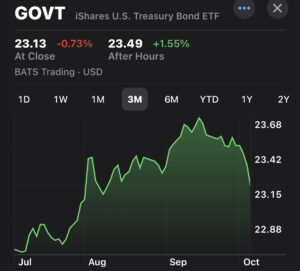Egg on its face
I saw a headline this morning proclaiming that the higher-than-expected non-farm-payrolls print would have the Fed rethinking the pace of its rate cuts.
Did you catch that? It was the wording that caught my eye. The pace of cuts is up for discussion. Whether there will be cuts is not. Wall Street is telling the Fed what it can and cannot do. It knows full well the Fed doesn’t like to surprise markets, so if it wants easy money (and when doesn’t it?) it need only create the expectation. Look at what’s happened in the past year … it’s been banging the rate cut drums at least since last fall. Finally, just a couple weeks ago, the Fed capitulated.
The Fed’s rationale was strained. It was now more afraid of unemployment than inflation. This isn’t a good sign, folks … the less the Fed worries about inflation, the more the markets have to. Then this morning’s employment report vomited all over those unemployment fears and the bond market puked.
But that’s a bit simplistic … in fact the bond market started getting queasy the day before the last Fed announcement. On a market weighted maturity basis, Treasury bond yields troughed and prices peaked on September 16. They backed up a bit September 17. The Fed announced an aggressive 50 bp rate cut September 18.

The market has been hiking rates since. Rising yields are indicated on this Treasury index fund chart as declining prices. In just the past week, the 10 year yield has risen from 3.75% to 3.98%, and the 1 year yield has risen from 3.90% to 4.20% … a 30 bp rate hike.
Yet all the while Wall Street media have missed no opportunity to remind the investing public that the Fed is on the rate cut warpath, the aforementioned headline being just one of many. Again, for a Fed obsessed with keeping policy in line with market expectations, this would make it extraordinarily difficult to do anything but cut rates. Such is the corner into which the Fed has boxed itself.
The market however is under no such artificial constraints. Free to follow the data, it has been hiking rates. The Fed can hide its head in the sand, but the bond market remains alert.
As I’ve relentlessly reminded readers, not the Fed but the bond market is the rate authority to pay heed to. The less the Fed worries about inflation, the more the rest of us need to. Resurgent inflation is already obvious in stock prices, commodity prices, and bond yields. It’s only a matter of time before it filters through to final consumer prices … before they’ve even recovered from the last round. If there is no clear reversal in these trends soon, they will be reaccelerating next year if not sooner.
Make of it what you will …
Costco is now selling platinum bars. Here’s what to know, from price to availability.
it’s hard to put much credence in the employment numbers, given that last year’s batch was recently revised down by 810,000. my guess is that the next cut, come nov [AFTER THE ELECTION!] will likely be 25bps instead of the 50bps the market has been hoping for.
.
it’s all theater, of course. the economy is not going to be very influenced by 25bps one way or the other. but financial markets will care. given that homeowners and large corporations all termed out their debt when rates were ultra-low, the domestic economy isn’t very sensitive to these changes, but i think it can make a difference in fx, and in foreign economies. i expect the short end to be coming down even as the long end heads back up.
.
vincent deluard, of stone-x, follows gov’t tax receipts. as he says, no one pays taxes who doesn’t have to, and those receipts indicate the economy is not in, nor is it entering, a recession.
.
otoh, with inflation headed back up [imo] we can have slow or neg growth while nominal gdp still increases. this, of course, is financial repression and what is necessary to lower the gov’t debt/gdp ratio.
I put no credence in the employment numbers. Don’t care about ‘em. I rarely cite them, and never rely on them. Least of all in this post, where the data of interest is media reporting and bond yields.
The bond market doesn’t much care either. It started hiking rates the day before the Fed announcement, over two weeks before Friday’s data release. It’s clearly Fed policy, not ecodata, that’s spooking the bond market. Employment costs bond investors nothing, inflation a lot.
Inflation Isn’t Tamed Yet. The Loneliest Fed Governor Was Right.